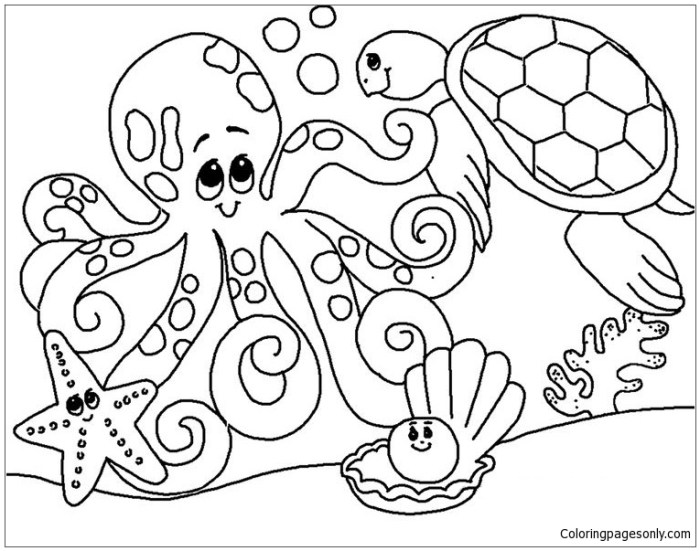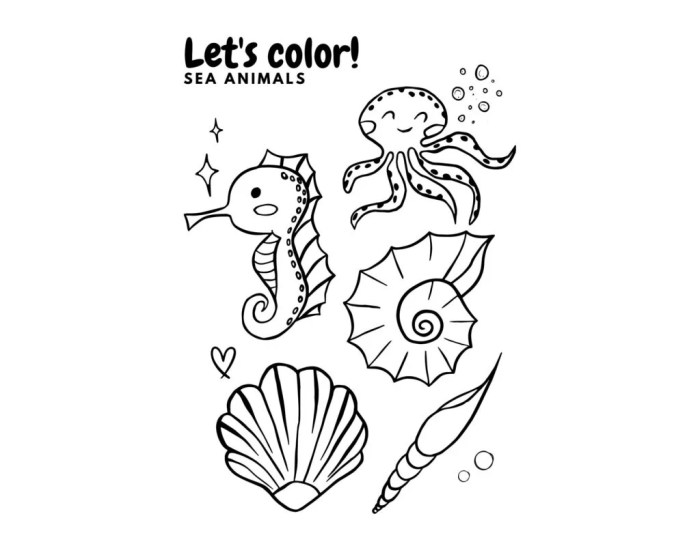Popularity and Trends

Coloring page of ocean animals – Ocean animal coloring pages enjoy widespread popularity, captivating audiences of all ages. Their enduring appeal stems from the inherent beauty and wonder of marine life, combined with the relaxing and creative benefits of coloring. The accessibility of digital resources and readily available printable options further fuels this popularity.Ocean animal coloring pages are not just a static pastime; they reflect evolving design trends and reflect shifts in popular culture.
This dynamic nature ensures their continued relevance and appeal to a broad spectrum of individuals.
Current Popularity of Ocean Animal Coloring Pages
The popularity of ocean animal coloring pages is significant and demonstrably increasing, particularly in the digital age. Websites offering free printable coloring pages and online coloring platforms see a consistently high volume of traffic and downloads related to marine life themes. The rise of mindful coloring as a stress-reduction technique has also contributed to this surge in popularity. Social media platforms showcase countless examples of completed coloring pages, fostering a sense of community and shared creative expression.
This visible engagement further boosts the popularity of this activity.
Emerging Trends in Ocean Animal Coloring Page Designs
Three notable trends are shaping the design of ocean animal coloring pages: intricate detail, realistic portrayal, and incorporation of educational elements. Firstly, intricate designs featuring complex patterns and textures offer a more challenging and rewarding coloring experience for advanced colorists. Secondly, realistic depictions of ocean animals, moving beyond simplistic Artikels to include nuanced shading and textures, appeal to those seeking a more visually stimulating activity.
Thirdly, the integration of educational elements, such as labeling anatomical features or including facts about the depicted animals, adds a learning dimension, broadening the appeal to educators and parents.
Popularity of Different Ocean Animals, Coloring page of ocean animals
Dolphins, whales, and sea turtles consistently rank among the most popular ocean animals featured in coloring pages. Dolphins, with their playful and intelligent nature, are frequently depicted in dynamic poses, appealing to a wide age range. Whales, particularly larger species like humpback whales, often feature in majestic illustrations highlighting their size and beauty. Sea turtles, symbols of longevity and grace, evoke a sense of calm and tranquility, making them a popular choice for relaxing coloring sessions.
However, the popularity can also fluctuate based on current events, for example, a documentary featuring a specific species might lead to a temporary increase in its depiction in coloring pages.
Age Groups Interested in Ocean Animal Coloring Pages
Ocean animal coloring pages cater to a broad spectrum of age groups. Younger children (preschool to early elementary) are drawn to simpler designs featuring bold Artikels and bright colors. Older children and teenagers may prefer more complex designs, allowing for greater creative expression and detail work. Adults also find these coloring pages a valuable tool for stress relief and creative outlet, appreciating the intricate designs and the opportunity for focused concentration.
The versatility of these coloring pages, therefore, makes them appealing across a wide age range, from toddlers to adults.
Design Elements: Coloring Page Of Ocean Animals

Ocean animal coloring pages, like miniature underwater worlds, offer a canvas for creativity. Their design, encompassing complexity, style, and color palettes, significantly impacts their appeal and engagement. A well-designed coloring page can inspire hours of focused activity and artistic expression. Let’s delve into the specifics.
Common design elements in ocean animal coloring pages vary widely depending on the target audience and intended style. Complexity ranges from simple Artikels suitable for young children to intricate designs with fine details for older children and adults. Styles can be realistic, capturing the accurate physical features of marine life, or cartoonish, employing exaggerated features and playful expressions. Color palettes can be vibrant and bold, reflecting the underwater spectrum, or muted and naturalistic, aiming for realism.
The interplay of these elements determines the overall aesthetic and the level of challenge presented to the colorist.
Coloring Page Layouts
Three distinct layouts exemplify the diversity in ocean animal coloring page design.
Firstly, a realistic layout would feature a detailed depiction of a whale, for instance, with accurate anatomical details, shading suggestions, and a complex texture for the skin. The background might include subtly rendered ocean waves and perhaps other smaller marine creatures in the distance, maintaining a sense of scale and environmental context. The overall feel would be serene and scientifically accurate.
Secondly, a cartoonish layout could portray a playful octopus with large, expressive eyes and exaggerated tentacles. Simple shapes and bold lines would define the octopus, making it easily colorable for younger children. The background could be a simple, brightly colored coral reef with similarly stylized coral and fish. This design emphasizes fun and simplicity.
Thirdly, an abstract layout might represent a dolphin through a series of interconnected shapes and patterns, focusing on form and texture rather than precise anatomical accuracy. The use of negative space would be crucial in this design, allowing the dolphin’s form to emerge from the surrounding shapes. The color palette could be monochromatic or use a limited number of complementary colors, creating a visually striking, modern aesthetic.
Impact of Design Elements on Visual Appeal
The following table showcases how different design elements contribute to the visual appeal of ocean animal coloring pages.
| Design Element | Description | Impact on Visual Appeal | Example |
|---|---|---|---|
| Complexity | Level of detail and intricacy in the design. | High complexity can be challenging but rewarding; low complexity is suitable for younger children. | A highly detailed anglerfish versus a simple starfish Artikel. |
| Style | Realistic, cartoonish, abstract, etc. | Influences the overall mood and target audience. | A photorealistic sea turtle versus a whimsical cartoon crab. |
| Color Palette | Range and combination of colors used. | Sets the tone and enhances the visual impact. | A vibrant, tropical palette versus a cool, oceanic palette. |
| Positive/Negative Space | Balance between the subject and the surrounding empty space. | Effective use enhances the subject’s prominence and overall composition. | A large, centrally placed whale with minimal background versus a smaller fish cleverly integrated into a detailed coral reef background. |
Positive and Negative Space
Effective use of positive and negative space is crucial in creating visually appealing coloring pages. For instance, a large, simple Artikel of a seahorse against a blank background allows the seahorse to dominate the page, creating a clear focal point. Conversely, a smaller, more intricate design of a jellyfish could be incorporated into a busy, detailed background of seaweed and bubbles, using the negative space within the seaweed to define the jellyfish’s form and enhance the overall complexity and interest of the design.
The balance between these elements creates visual harmony and guides the eye effectively.


